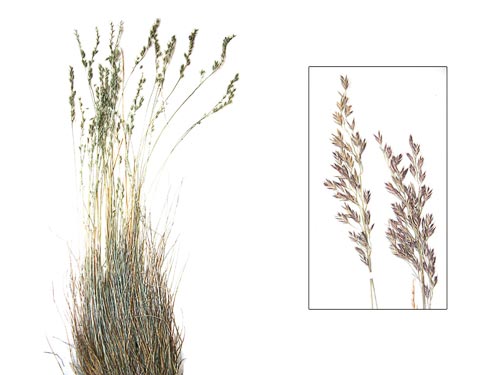Crops
Festuca ovina L. - Sheep fescue.
Taxonomic position.
Family Poaceae Barnhart., genus Festuca L.Biology and morphology.
Chromosome number: 2n = 28. Perennial plant, small size, hairless, cespitous. Stems erect, glabrous 30 - 60 cm high. Needle blade, narrow (about 1,0 mm), greyish green to bluish green, rough. Ligule very short. Auricles very reduced, sometimes distinct. Maximum number of leaves per tiller: 6,2. Panicle-like inflorescence, short (3 to 8 cm), with erect or more or less spreading branches. Spikelets with 3 - 6 aristate flowers. The weight of 1000 seeds is 0,8 to 1,0 g (average seeds). Blossoms in June, seed ripening - July. Cross-pollinated by wind.Distribution.
Introduced into culture since the end of XIX century. Cultivated on small squares in wood and steppe areas at 136 regions and republics of former USSR countries. 9 breeding cultivars for lawn and pasture purposes have the state permission for utilization.Ecology.
Typical xeromesophyte. High resistance to drought. Does not tolerate humidity. High resistance to cold. Does not tolerate shade. Restricted to very dry soils. Only on soils very poor in nutrients, very acid or, at the opposite, basic. It can be found on sandy soils or on very shallow stony soils originating from very diverse parental rocks. Low resistance to high water tables. Most varieties are very resistant to drought, cold temperatures and heavy grazing. Respective to irrigation.Utilization and economic value.
Valuable component of grasses mixtures for cultural long-lived pastures in the steppe and desert areas. Regrows in the end of April and is good for grazing in the first part of May or for early harvest. Provides good forage value for all classes of livestock. Good regrowth after 3-4 grazings. Highly palatable. Excellent for soil protection and is used for fast and reliable rehabilitation of watersheds. Improves soil?s structure and fertilization. Forage yield is approximately 4,0-8,0 MT/ha; average seed yield is 50-200 kg/ha. Used as a lawn grass, too.Literature:
Golovkin B. N. 1988. Cultigenic plant area. - M.: Nauka, 184 pp. (in Russian).Medvedev P. F., Smetannikova A. I. 1981. The forage crops of European part of the USSR.- L.: Kolos, 336 pp. (in Russian).
Shashko D. N. 1967. Agroclimatic region of the USSR.- M.: Kolos, 335 pp. (in Russian).
Shashko D. N. 1985. Agroclimatic resources of the USSR. - M.: Kolos, 248 pp. (in Russian).
Soil resources of the USSR (Agricultural regions of areas and republics of USSR). 1990. - M.: - Vol 1. - 260 pp. (in Russian).
State register of breeding achievements permitted for utilization. Plant cultivars. 2003. - M.: - 236 pp. (in Russian).
State register of breeding achievements permitted for utilization. Plant cultivars. 2004. - M.: - 236 pp. (in Russian).
State register of breeding achievements permitted for utilization. Plant cultivars. 2005. - M.: - 220 pp. (in Russian).
The Natural-agricultural regions and utilization of soil resources of the USSR. 1983. A. N. Kashtanov (ed.).- M.: Kolos, 336 pp. (in Russian).


